Ebola Virus Disease: Transmission, Treatment, and Prevention
VerifiedAdded on 2023/01/19
|10
|2803
|24
AI Summary
This article provides an overview of Ebola Virus Disease, including its transmission, treatment, and prevention. It discusses the symptoms of the disease, the history of outbreaks, and the efforts to find a vaccine and treatment. The article also highlights the challenges in managing the disease and the importance of creating awareness among the public.
Contribute Materials
Your contribution can guide someone’s learning journey. Share your
documents today.

Running Head: EBOLA VIRUS DISEASE
Ebola Virus Disease
Students Name
University Affiliation
Date
Ebola Virus Disease
Students Name
University Affiliation
Date
Secure Best Marks with AI Grader
Need help grading? Try our AI Grader for instant feedback on your assignments.
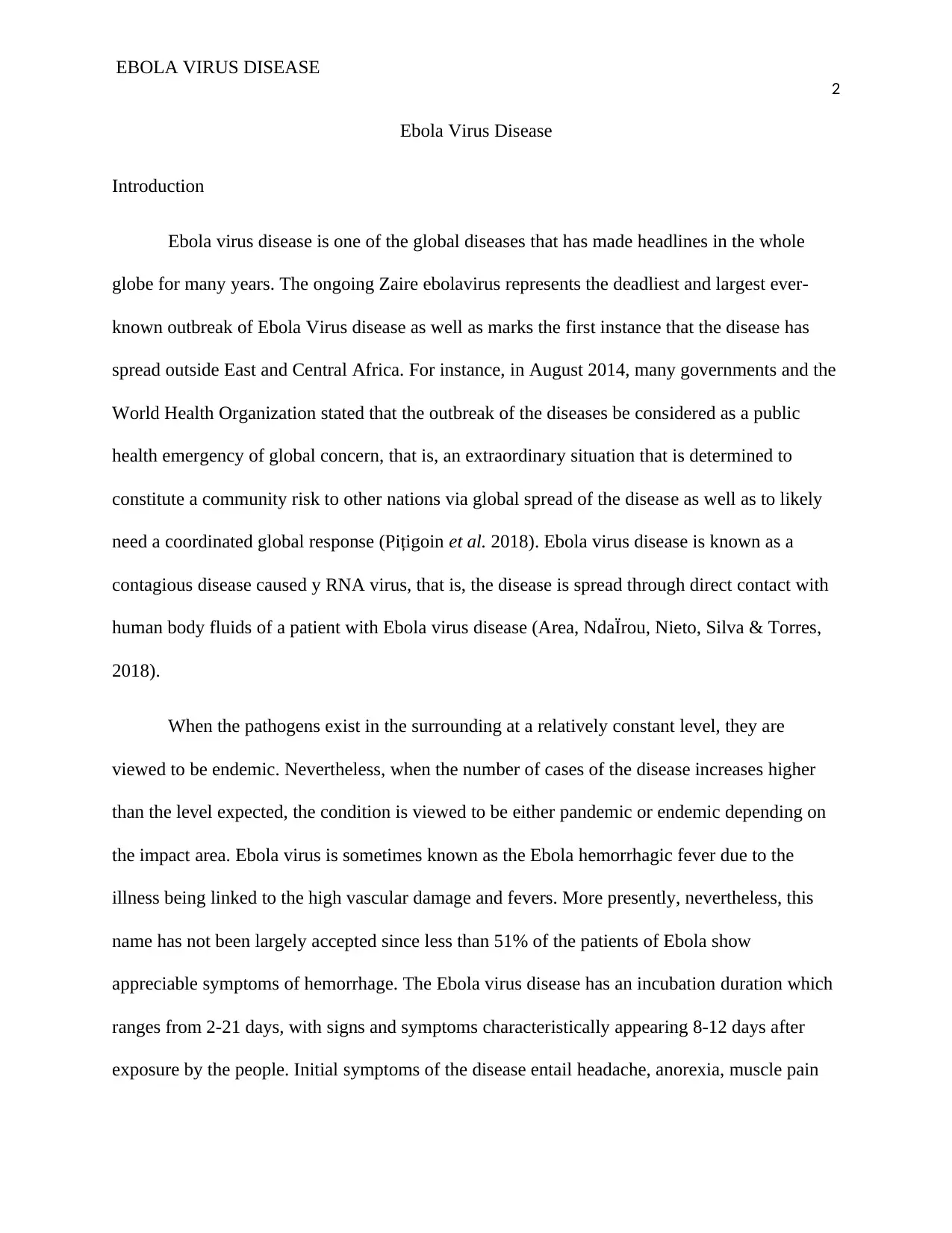
EBOLA VIRUS DISEASE
2
Ebola Virus Disease
Introduction
Ebola virus disease is one of the global diseases that has made headlines in the whole
globe for many years. The ongoing Zaire ebolavirus represents the deadliest and largest ever-
known outbreak of Ebola Virus disease as well as marks the first instance that the disease has
spread outside East and Central Africa. For instance, in August 2014, many governments and the
World Health Organization stated that the outbreak of the diseases be considered as a public
health emergency of global concern, that is, an extraordinary situation that is determined to
constitute a community risk to other nations via global spread of the disease as well as to likely
need a coordinated global response (Pițigoin et al. 2018). Ebola virus disease is known as a
contagious disease caused y RNA virus, that is, the disease is spread through direct contact with
human body fluids of a patient with Ebola virus disease (Area, NdaÏrou, Nieto, Silva & Torres,
2018).
When the pathogens exist in the surrounding at a relatively constant level, they are
viewed to be endemic. Nevertheless, when the number of cases of the disease increases higher
than the level expected, the condition is viewed to be either pandemic or endemic depending on
the impact area. Ebola virus is sometimes known as the Ebola hemorrhagic fever due to the
illness being linked to the high vascular damage and fevers. More presently, nevertheless, this
name has not been largely accepted since less than 51% of the patients of Ebola show
appreciable symptoms of hemorrhage. The Ebola virus disease has an incubation duration which
ranges from 2-21 days, with signs and symptoms characteristically appearing 8-12 days after
exposure by the people. Initial symptoms of the disease entail headache, anorexia, muscle pain
2
Ebola Virus Disease
Introduction
Ebola virus disease is one of the global diseases that has made headlines in the whole
globe for many years. The ongoing Zaire ebolavirus represents the deadliest and largest ever-
known outbreak of Ebola Virus disease as well as marks the first instance that the disease has
spread outside East and Central Africa. For instance, in August 2014, many governments and the
World Health Organization stated that the outbreak of the diseases be considered as a public
health emergency of global concern, that is, an extraordinary situation that is determined to
constitute a community risk to other nations via global spread of the disease as well as to likely
need a coordinated global response (Pițigoin et al. 2018). Ebola virus disease is known as a
contagious disease caused y RNA virus, that is, the disease is spread through direct contact with
human body fluids of a patient with Ebola virus disease (Area, NdaÏrou, Nieto, Silva & Torres,
2018).
When the pathogens exist in the surrounding at a relatively constant level, they are
viewed to be endemic. Nevertheless, when the number of cases of the disease increases higher
than the level expected, the condition is viewed to be either pandemic or endemic depending on
the impact area. Ebola virus is sometimes known as the Ebola hemorrhagic fever due to the
illness being linked to the high vascular damage and fevers. More presently, nevertheless, this
name has not been largely accepted since less than 51% of the patients of Ebola show
appreciable symptoms of hemorrhage. The Ebola virus disease has an incubation duration which
ranges from 2-21 days, with signs and symptoms characteristically appearing 8-12 days after
exposure by the people. Initial symptoms of the disease entail headache, anorexia, muscle pain
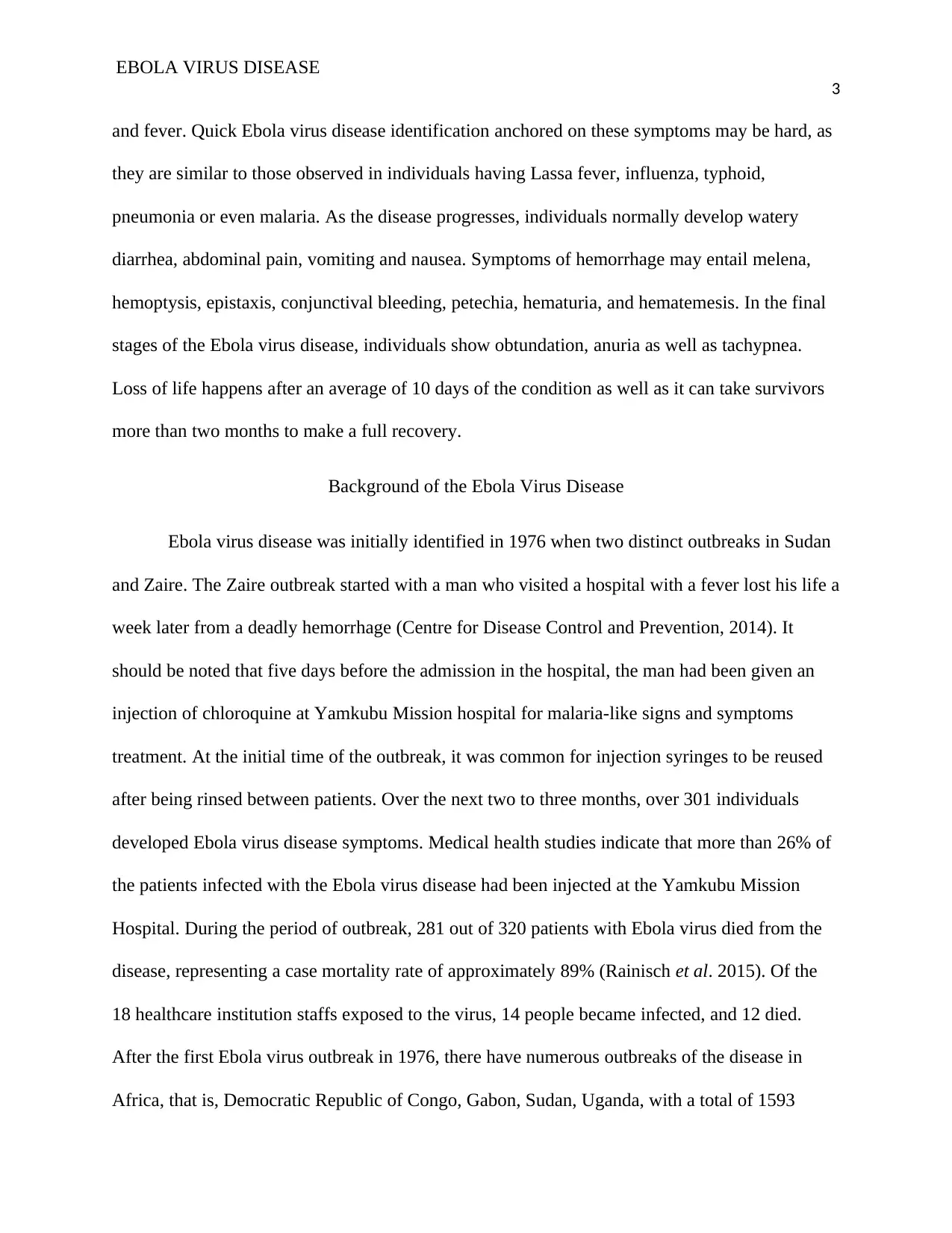
EBOLA VIRUS DISEASE
3
and fever. Quick Ebola virus disease identification anchored on these symptoms may be hard, as
they are similar to those observed in individuals having Lassa fever, influenza, typhoid,
pneumonia or even malaria. As the disease progresses, individuals normally develop watery
diarrhea, abdominal pain, vomiting and nausea. Symptoms of hemorrhage may entail melena,
hemoptysis, epistaxis, conjunctival bleeding, petechia, hematuria, and hematemesis. In the final
stages of the Ebola virus disease, individuals show obtundation, anuria as well as tachypnea.
Loss of life happens after an average of 10 days of the condition as well as it can take survivors
more than two months to make a full recovery.
Background of the Ebola Virus Disease
Ebola virus disease was initially identified in 1976 when two distinct outbreaks in Sudan
and Zaire. The Zaire outbreak started with a man who visited a hospital with a fever lost his life a
week later from a deadly hemorrhage (Centre for Disease Control and Prevention, 2014). It
should be noted that five days before the admission in the hospital, the man had been given an
injection of chloroquine at Yamkubu Mission hospital for malaria-like signs and symptoms
treatment. At the initial time of the outbreak, it was common for injection syringes to be reused
after being rinsed between patients. Over the next two to three months, over 301 individuals
developed Ebola virus disease symptoms. Medical health studies indicate that more than 26% of
the patients infected with the Ebola virus disease had been injected at the Yamkubu Mission
Hospital. During the period of outbreak, 281 out of 320 patients with Ebola virus died from the
disease, representing a case mortality rate of approximately 89% (Rainisch et al. 2015). Of the
18 healthcare institution staffs exposed to the virus, 14 people became infected, and 12 died.
After the first Ebola virus outbreak in 1976, there have numerous outbreaks of the disease in
Africa, that is, Democratic Republic of Congo, Gabon, Sudan, Uganda, with a total of 1593
3
and fever. Quick Ebola virus disease identification anchored on these symptoms may be hard, as
they are similar to those observed in individuals having Lassa fever, influenza, typhoid,
pneumonia or even malaria. As the disease progresses, individuals normally develop watery
diarrhea, abdominal pain, vomiting and nausea. Symptoms of hemorrhage may entail melena,
hemoptysis, epistaxis, conjunctival bleeding, petechia, hematuria, and hematemesis. In the final
stages of the Ebola virus disease, individuals show obtundation, anuria as well as tachypnea.
Loss of life happens after an average of 10 days of the condition as well as it can take survivors
more than two months to make a full recovery.
Background of the Ebola Virus Disease
Ebola virus disease was initially identified in 1976 when two distinct outbreaks in Sudan
and Zaire. The Zaire outbreak started with a man who visited a hospital with a fever lost his life a
week later from a deadly hemorrhage (Centre for Disease Control and Prevention, 2014). It
should be noted that five days before the admission in the hospital, the man had been given an
injection of chloroquine at Yamkubu Mission hospital for malaria-like signs and symptoms
treatment. At the initial time of the outbreak, it was common for injection syringes to be reused
after being rinsed between patients. Over the next two to three months, over 301 individuals
developed Ebola virus disease symptoms. Medical health studies indicate that more than 26% of
the patients infected with the Ebola virus disease had been injected at the Yamkubu Mission
Hospital. During the period of outbreak, 281 out of 320 patients with Ebola virus died from the
disease, representing a case mortality rate of approximately 89% (Rainisch et al. 2015). Of the
18 healthcare institution staffs exposed to the virus, 14 people became infected, and 12 died.
After the first Ebola virus outbreak in 1976, there have numerous outbreaks of the disease in
Africa, that is, Democratic Republic of Congo, Gabon, Sudan, Uganda, with a total of 1593
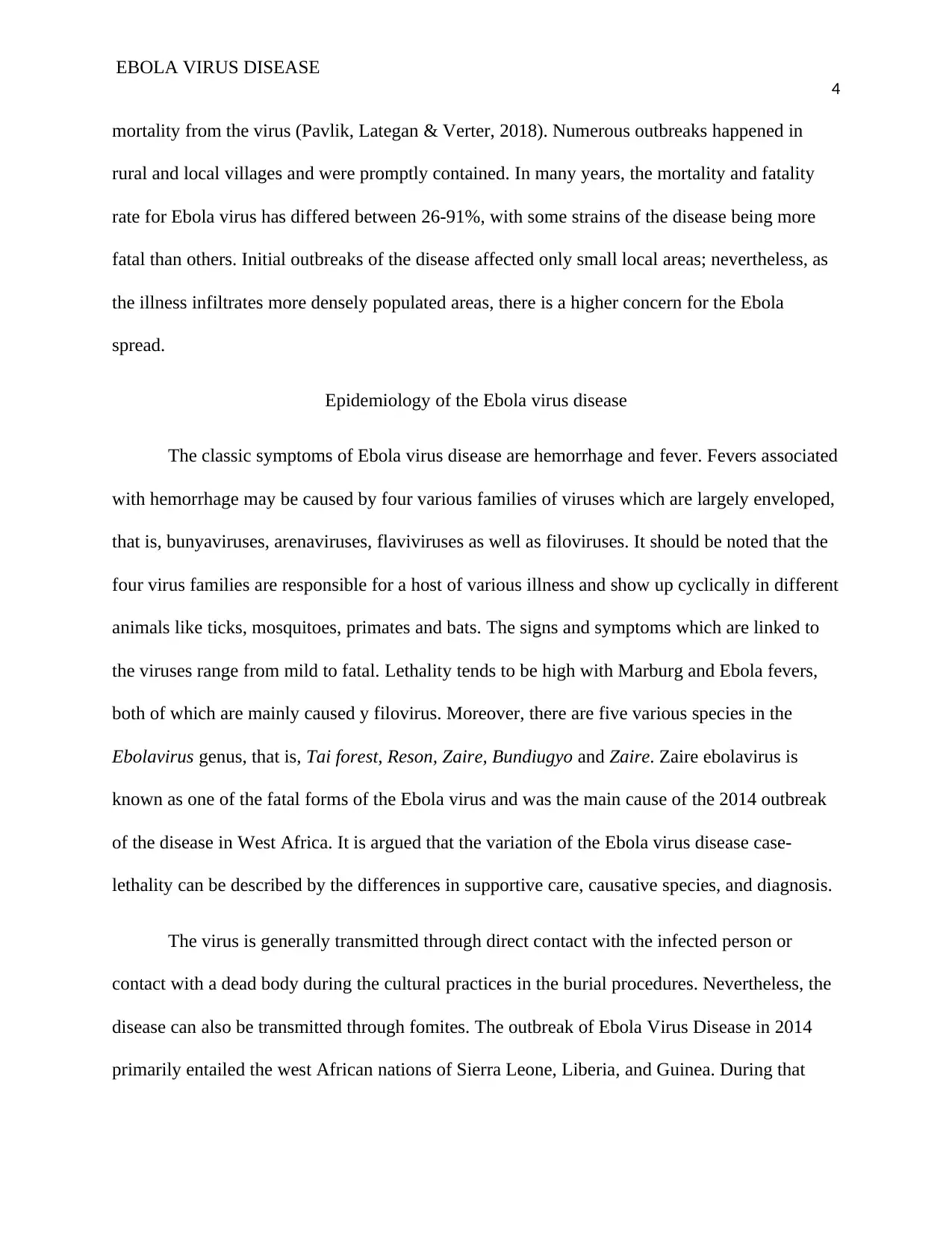
EBOLA VIRUS DISEASE
4
mortality from the virus (Pavlik, Lategan & Verter, 2018). Numerous outbreaks happened in
rural and local villages and were promptly contained. In many years, the mortality and fatality
rate for Ebola virus has differed between 26-91%, with some strains of the disease being more
fatal than others. Initial outbreaks of the disease affected only small local areas; nevertheless, as
the illness infiltrates more densely populated areas, there is a higher concern for the Ebola
spread.
Epidemiology of the Ebola virus disease
The classic symptoms of Ebola virus disease are hemorrhage and fever. Fevers associated
with hemorrhage may be caused by four various families of viruses which are largely enveloped,
that is, bunyaviruses, arenaviruses, flaviviruses as well as filoviruses. It should be noted that the
four virus families are responsible for a host of various illness and show up cyclically in different
animals like ticks, mosquitoes, primates and bats. The signs and symptoms which are linked to
the viruses range from mild to fatal. Lethality tends to be high with Marburg and Ebola fevers,
both of which are mainly caused y filovirus. Moreover, there are five various species in the
Ebolavirus genus, that is, Tai forest, Reson, Zaire, Bundiugyo and Zaire. Zaire ebolavirus is
known as one of the fatal forms of the Ebola virus and was the main cause of the 2014 outbreak
of the disease in West Africa. It is argued that the variation of the Ebola virus disease case-
lethality can be described by the differences in supportive care, causative species, and diagnosis.
The virus is generally transmitted through direct contact with the infected person or
contact with a dead body during the cultural practices in the burial procedures. Nevertheless, the
disease can also be transmitted through fomites. The outbreak of Ebola Virus Disease in 2014
primarily entailed the west African nations of Sierra Leone, Liberia, and Guinea. During that
4
mortality from the virus (Pavlik, Lategan & Verter, 2018). Numerous outbreaks happened in
rural and local villages and were promptly contained. In many years, the mortality and fatality
rate for Ebola virus has differed between 26-91%, with some strains of the disease being more
fatal than others. Initial outbreaks of the disease affected only small local areas; nevertheless, as
the illness infiltrates more densely populated areas, there is a higher concern for the Ebola
spread.
Epidemiology of the Ebola virus disease
The classic symptoms of Ebola virus disease are hemorrhage and fever. Fevers associated
with hemorrhage may be caused by four various families of viruses which are largely enveloped,
that is, bunyaviruses, arenaviruses, flaviviruses as well as filoviruses. It should be noted that the
four virus families are responsible for a host of various illness and show up cyclically in different
animals like ticks, mosquitoes, primates and bats. The signs and symptoms which are linked to
the viruses range from mild to fatal. Lethality tends to be high with Marburg and Ebola fevers,
both of which are mainly caused y filovirus. Moreover, there are five various species in the
Ebolavirus genus, that is, Tai forest, Reson, Zaire, Bundiugyo and Zaire. Zaire ebolavirus is
known as one of the fatal forms of the Ebola virus and was the main cause of the 2014 outbreak
of the disease in West Africa. It is argued that the variation of the Ebola virus disease case-
lethality can be described by the differences in supportive care, causative species, and diagnosis.
The virus is generally transmitted through direct contact with the infected person or
contact with a dead body during the cultural practices in the burial procedures. Nevertheless, the
disease can also be transmitted through fomites. The outbreak of Ebola Virus Disease in 2014
primarily entailed the west African nations of Sierra Leone, Liberia, and Guinea. During that
Secure Best Marks with AI Grader
Need help grading? Try our AI Grader for instant feedback on your assignments.
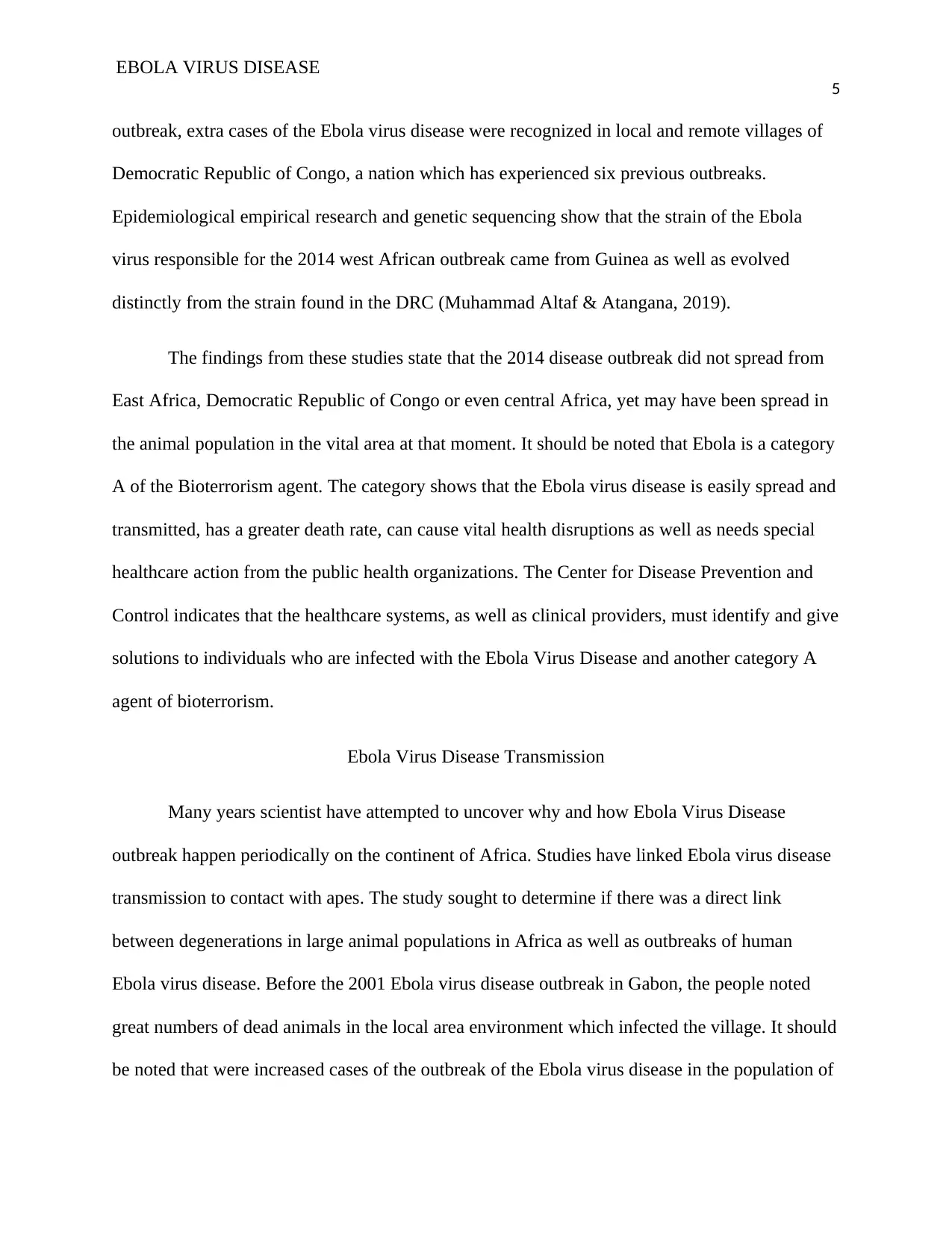
EBOLA VIRUS DISEASE
5
outbreak, extra cases of the Ebola virus disease were recognized in local and remote villages of
Democratic Republic of Congo, a nation which has experienced six previous outbreaks.
Epidemiological empirical research and genetic sequencing show that the strain of the Ebola
virus responsible for the 2014 west African outbreak came from Guinea as well as evolved
distinctly from the strain found in the DRC (Muhammad Altaf & Atangana, 2019).
The findings from these studies state that the 2014 disease outbreak did not spread from
East Africa, Democratic Republic of Congo or even central Africa, yet may have been spread in
the animal population in the vital area at that moment. It should be noted that Ebola is a category
A of the Bioterrorism agent. The category shows that the Ebola virus disease is easily spread and
transmitted, has a greater death rate, can cause vital health disruptions as well as needs special
healthcare action from the public health organizations. The Center for Disease Prevention and
Control indicates that the healthcare systems, as well as clinical providers, must identify and give
solutions to individuals who are infected with the Ebola Virus Disease and another category A
agent of bioterrorism.
Ebola Virus Disease Transmission
Many years scientist have attempted to uncover why and how Ebola Virus Disease
outbreak happen periodically on the continent of Africa. Studies have linked Ebola virus disease
transmission to contact with apes. The study sought to determine if there was a direct link
between degenerations in large animal populations in Africa as well as outbreaks of human
Ebola virus disease. Before the 2001 Ebola virus disease outbreak in Gabon, the people noted
great numbers of dead animals in the local area environment which infected the village. It should
be noted that were increased cases of the outbreak of the Ebola virus disease in the population of
5
outbreak, extra cases of the Ebola virus disease were recognized in local and remote villages of
Democratic Republic of Congo, a nation which has experienced six previous outbreaks.
Epidemiological empirical research and genetic sequencing show that the strain of the Ebola
virus responsible for the 2014 west African outbreak came from Guinea as well as evolved
distinctly from the strain found in the DRC (Muhammad Altaf & Atangana, 2019).
The findings from these studies state that the 2014 disease outbreak did not spread from
East Africa, Democratic Republic of Congo or even central Africa, yet may have been spread in
the animal population in the vital area at that moment. It should be noted that Ebola is a category
A of the Bioterrorism agent. The category shows that the Ebola virus disease is easily spread and
transmitted, has a greater death rate, can cause vital health disruptions as well as needs special
healthcare action from the public health organizations. The Center for Disease Prevention and
Control indicates that the healthcare systems, as well as clinical providers, must identify and give
solutions to individuals who are infected with the Ebola Virus Disease and another category A
agent of bioterrorism.
Ebola Virus Disease Transmission
Many years scientist have attempted to uncover why and how Ebola Virus Disease
outbreak happen periodically on the continent of Africa. Studies have linked Ebola virus disease
transmission to contact with apes. The study sought to determine if there was a direct link
between degenerations in large animal populations in Africa as well as outbreaks of human
Ebola virus disease. Before the 2001 Ebola virus disease outbreak in Gabon, the people noted
great numbers of dead animals in the local area environment which infected the village. It should
be noted that were increased cases of the outbreak of the Ebola virus disease in the population of
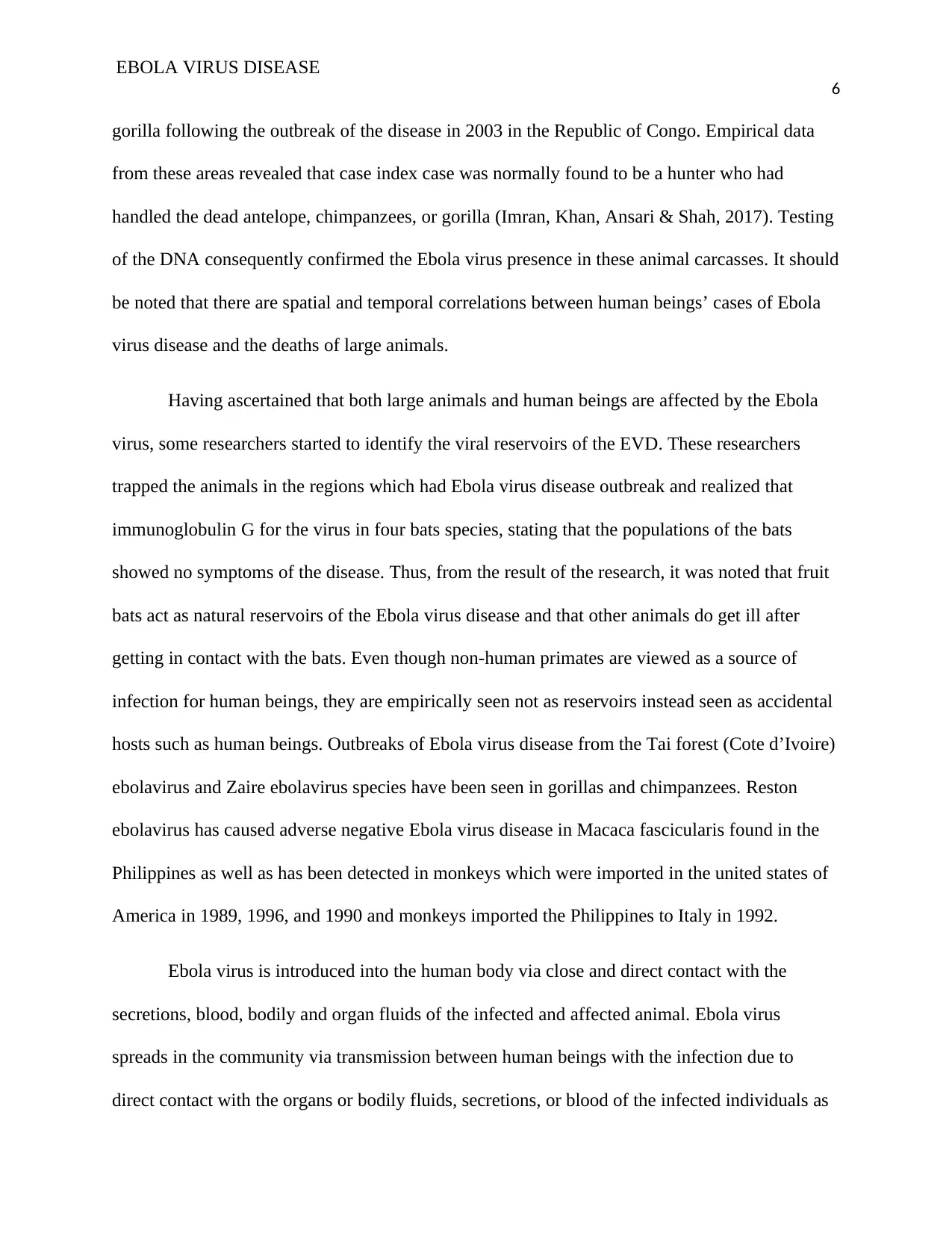
EBOLA VIRUS DISEASE
6
gorilla following the outbreak of the disease in 2003 in the Republic of Congo. Empirical data
from these areas revealed that case index case was normally found to be a hunter who had
handled the dead antelope, chimpanzees, or gorilla (Imran, Khan, Ansari & Shah, 2017). Testing
of the DNA consequently confirmed the Ebola virus presence in these animal carcasses. It should
be noted that there are spatial and temporal correlations between human beings’ cases of Ebola
virus disease and the deaths of large animals.
Having ascertained that both large animals and human beings are affected by the Ebola
virus, some researchers started to identify the viral reservoirs of the EVD. These researchers
trapped the animals in the regions which had Ebola virus disease outbreak and realized that
immunoglobulin G for the virus in four bats species, stating that the populations of the bats
showed no symptoms of the disease. Thus, from the result of the research, it was noted that fruit
bats act as natural reservoirs of the Ebola virus disease and that other animals do get ill after
getting in contact with the bats. Even though non-human primates are viewed as a source of
infection for human beings, they are empirically seen not as reservoirs instead seen as accidental
hosts such as human beings. Outbreaks of Ebola virus disease from the Tai forest (Cote d’Ivoire)
ebolavirus and Zaire ebolavirus species have been seen in gorillas and chimpanzees. Reston
ebolavirus has caused adverse negative Ebola virus disease in Macaca fascicularis found in the
Philippines as well as has been detected in monkeys which were imported in the united states of
America in 1989, 1996, and 1990 and monkeys imported the Philippines to Italy in 1992.
Ebola virus is introduced into the human body via close and direct contact with the
secretions, blood, bodily and organ fluids of the infected and affected animal. Ebola virus
spreads in the community via transmission between human beings with the infection due to
direct contact with the organs or bodily fluids, secretions, or blood of the infected individuals as
6
gorilla following the outbreak of the disease in 2003 in the Republic of Congo. Empirical data
from these areas revealed that case index case was normally found to be a hunter who had
handled the dead antelope, chimpanzees, or gorilla (Imran, Khan, Ansari & Shah, 2017). Testing
of the DNA consequently confirmed the Ebola virus presence in these animal carcasses. It should
be noted that there are spatial and temporal correlations between human beings’ cases of Ebola
virus disease and the deaths of large animals.
Having ascertained that both large animals and human beings are affected by the Ebola
virus, some researchers started to identify the viral reservoirs of the EVD. These researchers
trapped the animals in the regions which had Ebola virus disease outbreak and realized that
immunoglobulin G for the virus in four bats species, stating that the populations of the bats
showed no symptoms of the disease. Thus, from the result of the research, it was noted that fruit
bats act as natural reservoirs of the Ebola virus disease and that other animals do get ill after
getting in contact with the bats. Even though non-human primates are viewed as a source of
infection for human beings, they are empirically seen not as reservoirs instead seen as accidental
hosts such as human beings. Outbreaks of Ebola virus disease from the Tai forest (Cote d’Ivoire)
ebolavirus and Zaire ebolavirus species have been seen in gorillas and chimpanzees. Reston
ebolavirus has caused adverse negative Ebola virus disease in Macaca fascicularis found in the
Philippines as well as has been detected in monkeys which were imported in the united states of
America in 1989, 1996, and 1990 and monkeys imported the Philippines to Italy in 1992.
Ebola virus is introduced into the human body via close and direct contact with the
secretions, blood, bodily and organ fluids of the infected and affected animal. Ebola virus
spreads in the community via transmission between human beings with the infection due to
direct contact with the organs or bodily fluids, secretions, or blood of the infected individuals as
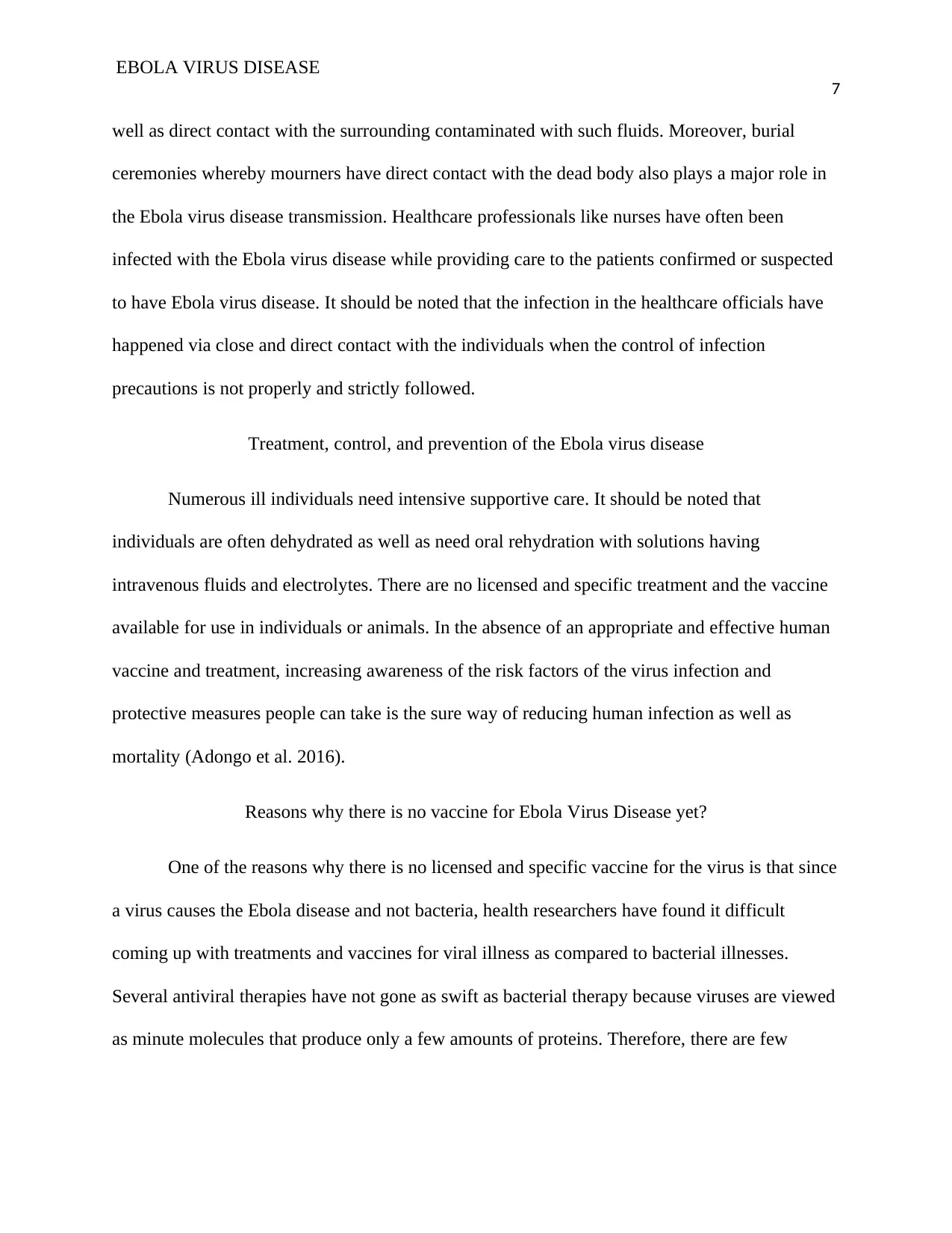
EBOLA VIRUS DISEASE
7
well as direct contact with the surrounding contaminated with such fluids. Moreover, burial
ceremonies whereby mourners have direct contact with the dead body also plays a major role in
the Ebola virus disease transmission. Healthcare professionals like nurses have often been
infected with the Ebola virus disease while providing care to the patients confirmed or suspected
to have Ebola virus disease. It should be noted that the infection in the healthcare officials have
happened via close and direct contact with the individuals when the control of infection
precautions is not properly and strictly followed.
Treatment, control, and prevention of the Ebola virus disease
Numerous ill individuals need intensive supportive care. It should be noted that
individuals are often dehydrated as well as need oral rehydration with solutions having
intravenous fluids and electrolytes. There are no licensed and specific treatment and the vaccine
available for use in individuals or animals. In the absence of an appropriate and effective human
vaccine and treatment, increasing awareness of the risk factors of the virus infection and
protective measures people can take is the sure way of reducing human infection as well as
mortality (Adongo et al. 2016).
Reasons why there is no vaccine for Ebola Virus Disease yet?
One of the reasons why there is no licensed and specific vaccine for the virus is that since
a virus causes the Ebola disease and not bacteria, health researchers have found it difficult
coming up with treatments and vaccines for viral illness as compared to bacterial illnesses.
Several antiviral therapies have not gone as swift as bacterial therapy because viruses are viewed
as minute molecules that produce only a few amounts of proteins. Therefore, there are few
7
well as direct contact with the surrounding contaminated with such fluids. Moreover, burial
ceremonies whereby mourners have direct contact with the dead body also plays a major role in
the Ebola virus disease transmission. Healthcare professionals like nurses have often been
infected with the Ebola virus disease while providing care to the patients confirmed or suspected
to have Ebola virus disease. It should be noted that the infection in the healthcare officials have
happened via close and direct contact with the individuals when the control of infection
precautions is not properly and strictly followed.
Treatment, control, and prevention of the Ebola virus disease
Numerous ill individuals need intensive supportive care. It should be noted that
individuals are often dehydrated as well as need oral rehydration with solutions having
intravenous fluids and electrolytes. There are no licensed and specific treatment and the vaccine
available for use in individuals or animals. In the absence of an appropriate and effective human
vaccine and treatment, increasing awareness of the risk factors of the virus infection and
protective measures people can take is the sure way of reducing human infection as well as
mortality (Adongo et al. 2016).
Reasons why there is no vaccine for Ebola Virus Disease yet?
One of the reasons why there is no licensed and specific vaccine for the virus is that since
a virus causes the Ebola disease and not bacteria, health researchers have found it difficult
coming up with treatments and vaccines for viral illness as compared to bacterial illnesses.
Several antiviral therapies have not gone as swift as bacterial therapy because viruses are viewed
as minute molecules that produce only a few amounts of proteins. Therefore, there are few
Paraphrase This Document
Need a fresh take? Get an instant paraphrase of this document with our AI Paraphraser
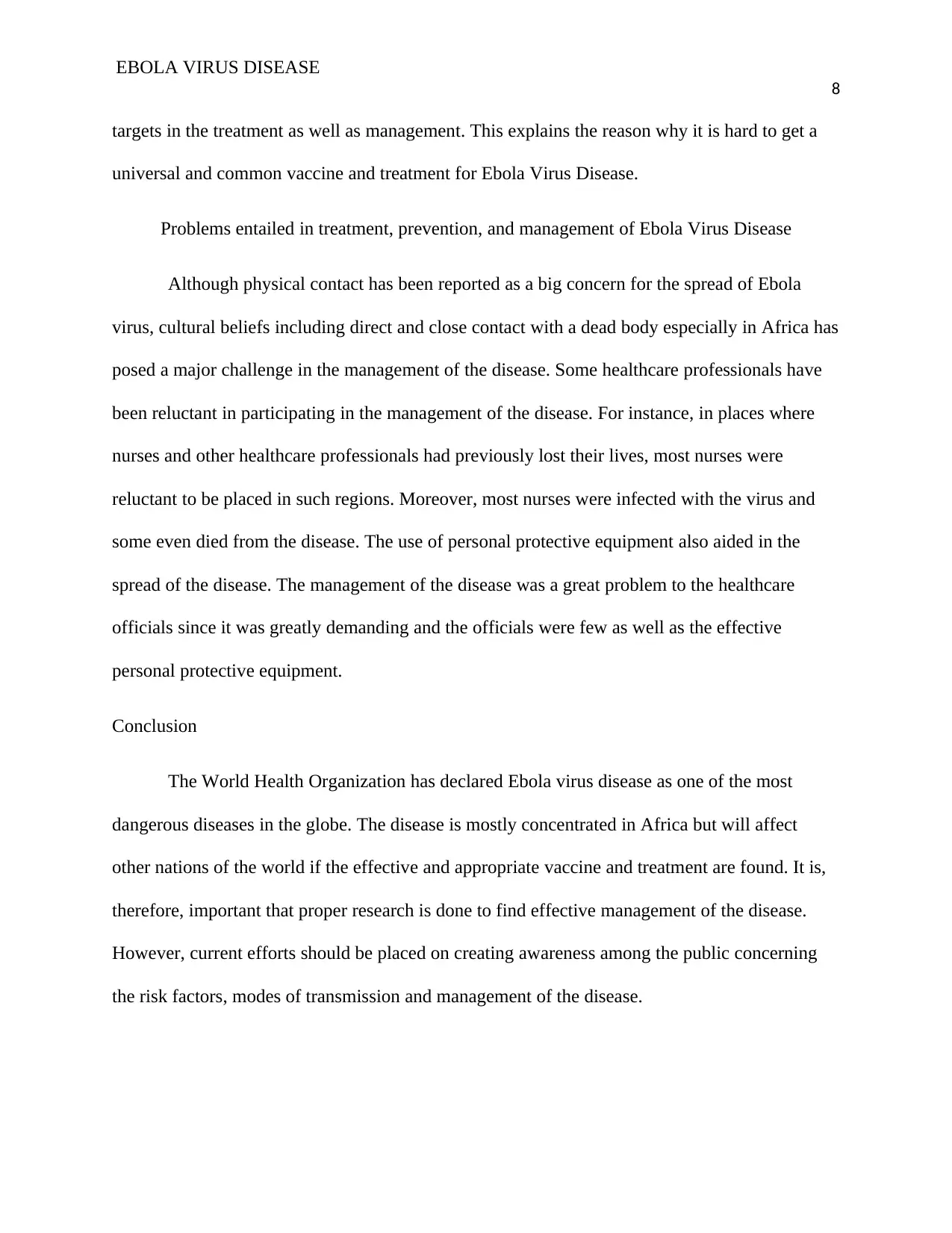
EBOLA VIRUS DISEASE
8
targets in the treatment as well as management. This explains the reason why it is hard to get a
universal and common vaccine and treatment for Ebola Virus Disease.
Problems entailed in treatment, prevention, and management of Ebola Virus Disease
Although physical contact has been reported as a big concern for the spread of Ebola
virus, cultural beliefs including direct and close contact with a dead body especially in Africa has
posed a major challenge in the management of the disease. Some healthcare professionals have
been reluctant in participating in the management of the disease. For instance, in places where
nurses and other healthcare professionals had previously lost their lives, most nurses were
reluctant to be placed in such regions. Moreover, most nurses were infected with the virus and
some even died from the disease. The use of personal protective equipment also aided in the
spread of the disease. The management of the disease was a great problem to the healthcare
officials since it was greatly demanding and the officials were few as well as the effective
personal protective equipment.
Conclusion
The World Health Organization has declared Ebola virus disease as one of the most
dangerous diseases in the globe. The disease is mostly concentrated in Africa but will affect
other nations of the world if the effective and appropriate vaccine and treatment are found. It is,
therefore, important that proper research is done to find effective management of the disease.
However, current efforts should be placed on creating awareness among the public concerning
the risk factors, modes of transmission and management of the disease.
8
targets in the treatment as well as management. This explains the reason why it is hard to get a
universal and common vaccine and treatment for Ebola Virus Disease.
Problems entailed in treatment, prevention, and management of Ebola Virus Disease
Although physical contact has been reported as a big concern for the spread of Ebola
virus, cultural beliefs including direct and close contact with a dead body especially in Africa has
posed a major challenge in the management of the disease. Some healthcare professionals have
been reluctant in participating in the management of the disease. For instance, in places where
nurses and other healthcare professionals had previously lost their lives, most nurses were
reluctant to be placed in such regions. Moreover, most nurses were infected with the virus and
some even died from the disease. The use of personal protective equipment also aided in the
spread of the disease. The management of the disease was a great problem to the healthcare
officials since it was greatly demanding and the officials were few as well as the effective
personal protective equipment.
Conclusion
The World Health Organization has declared Ebola virus disease as one of the most
dangerous diseases in the globe. The disease is mostly concentrated in Africa but will affect
other nations of the world if the effective and appropriate vaccine and treatment are found. It is,
therefore, important that proper research is done to find effective management of the disease.
However, current efforts should be placed on creating awareness among the public concerning
the risk factors, modes of transmission and management of the disease.
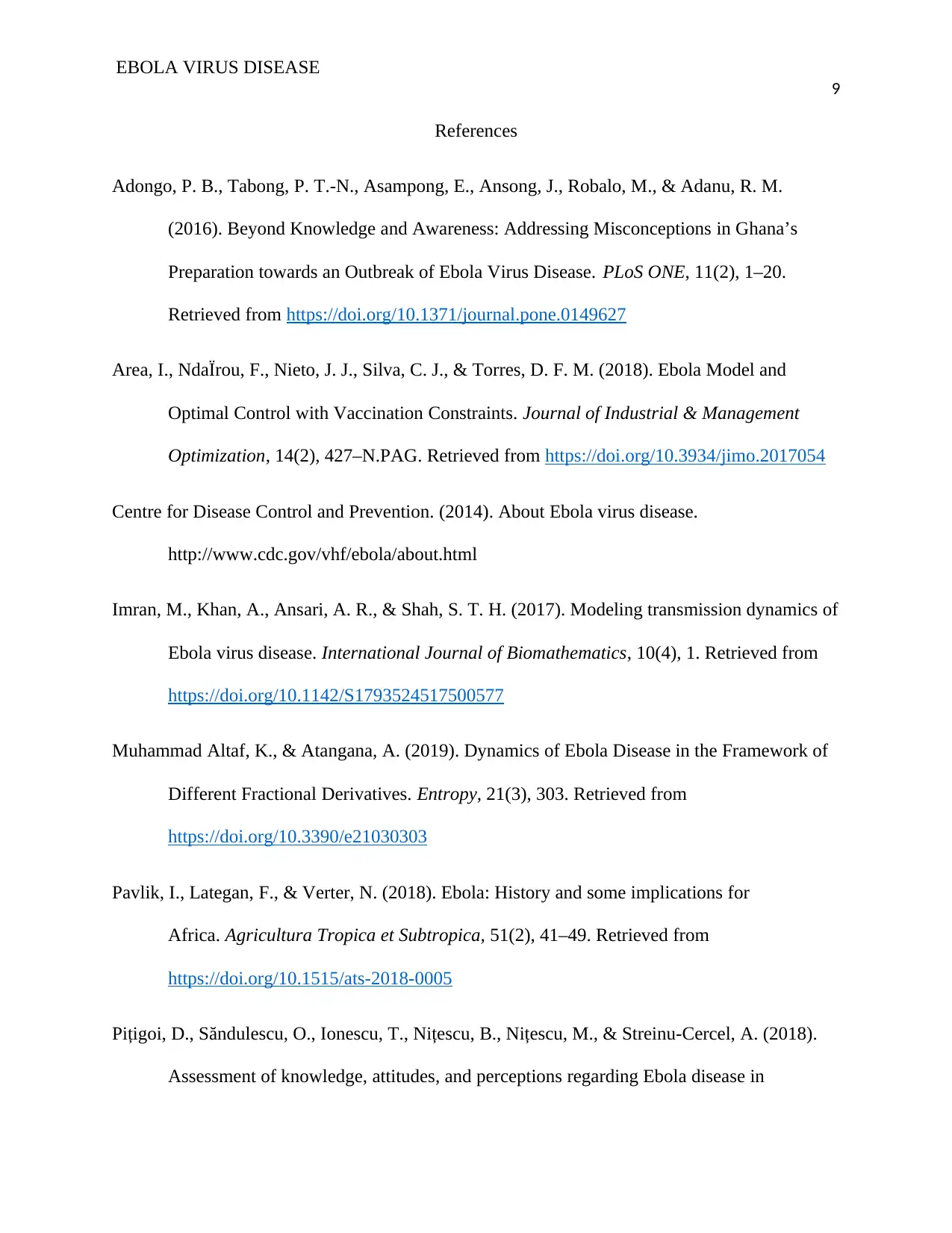
EBOLA VIRUS DISEASE
9
References
Adongo, P. B., Tabong, P. T.-N., Asampong, E., Ansong, J., Robalo, M., & Adanu, R. M.
(2016). Beyond Knowledge and Awareness: Addressing Misconceptions in Ghana’s
Preparation towards an Outbreak of Ebola Virus Disease. PLoS ONE, 11(2), 1–20.
Retrieved from https://doi.org/10.1371/journal.pone.0149627
Area, I., NdaÏrou, F., Nieto, J. J., Silva, C. J., & Torres, D. F. M. (2018). Ebola Model and
Optimal Control with Vaccination Constraints. Journal of Industrial & Management
Optimization, 14(2), 427–N.PAG. Retrieved from https://doi.org/10.3934/jimo.2017054
Centre for Disease Control and Prevention. (2014). About Ebola virus disease.
http://www.cdc.gov/vhf/ebola/about.html
Imran, M., Khan, A., Ansari, A. R., & Shah, S. T. H. (2017). Modeling transmission dynamics of
Ebola virus disease. International Journal of Biomathematics, 10(4), 1. Retrieved from
https://doi.org/10.1142/S1793524517500577
Muhammad Altaf, K., & Atangana, A. (2019). Dynamics of Ebola Disease in the Framework of
Different Fractional Derivatives. Entropy, 21(3), 303. Retrieved from
https://doi.org/10.3390/e21030303
Pavlik, I., Lategan, F., & Verter, N. (2018). Ebola: History and some implications for
Africa. Agricultura Tropica et Subtropica, 51(2), 41–49. Retrieved from
https://doi.org/10.1515/ats-2018-0005
Pițigoi, D., Săndulescu, O., Ionescu, T., Nițescu, B., Nițescu, M., & Streinu-Cercel, A. (2018).
Assessment of knowledge, attitudes, and perceptions regarding Ebola disease in
9
References
Adongo, P. B., Tabong, P. T.-N., Asampong, E., Ansong, J., Robalo, M., & Adanu, R. M.
(2016). Beyond Knowledge and Awareness: Addressing Misconceptions in Ghana’s
Preparation towards an Outbreak of Ebola Virus Disease. PLoS ONE, 11(2), 1–20.
Retrieved from https://doi.org/10.1371/journal.pone.0149627
Area, I., NdaÏrou, F., Nieto, J. J., Silva, C. J., & Torres, D. F. M. (2018). Ebola Model and
Optimal Control with Vaccination Constraints. Journal of Industrial & Management
Optimization, 14(2), 427–N.PAG. Retrieved from https://doi.org/10.3934/jimo.2017054
Centre for Disease Control and Prevention. (2014). About Ebola virus disease.
http://www.cdc.gov/vhf/ebola/about.html
Imran, M., Khan, A., Ansari, A. R., & Shah, S. T. H. (2017). Modeling transmission dynamics of
Ebola virus disease. International Journal of Biomathematics, 10(4), 1. Retrieved from
https://doi.org/10.1142/S1793524517500577
Muhammad Altaf, K., & Atangana, A. (2019). Dynamics of Ebola Disease in the Framework of
Different Fractional Derivatives. Entropy, 21(3), 303. Retrieved from
https://doi.org/10.3390/e21030303
Pavlik, I., Lategan, F., & Verter, N. (2018). Ebola: History and some implications for
Africa. Agricultura Tropica et Subtropica, 51(2), 41–49. Retrieved from
https://doi.org/10.1515/ats-2018-0005
Pițigoi, D., Săndulescu, O., Ionescu, T., Nițescu, B., Nițescu, M., & Streinu-Cercel, A. (2018).
Assessment of knowledge, attitudes, and perceptions regarding Ebola disease in
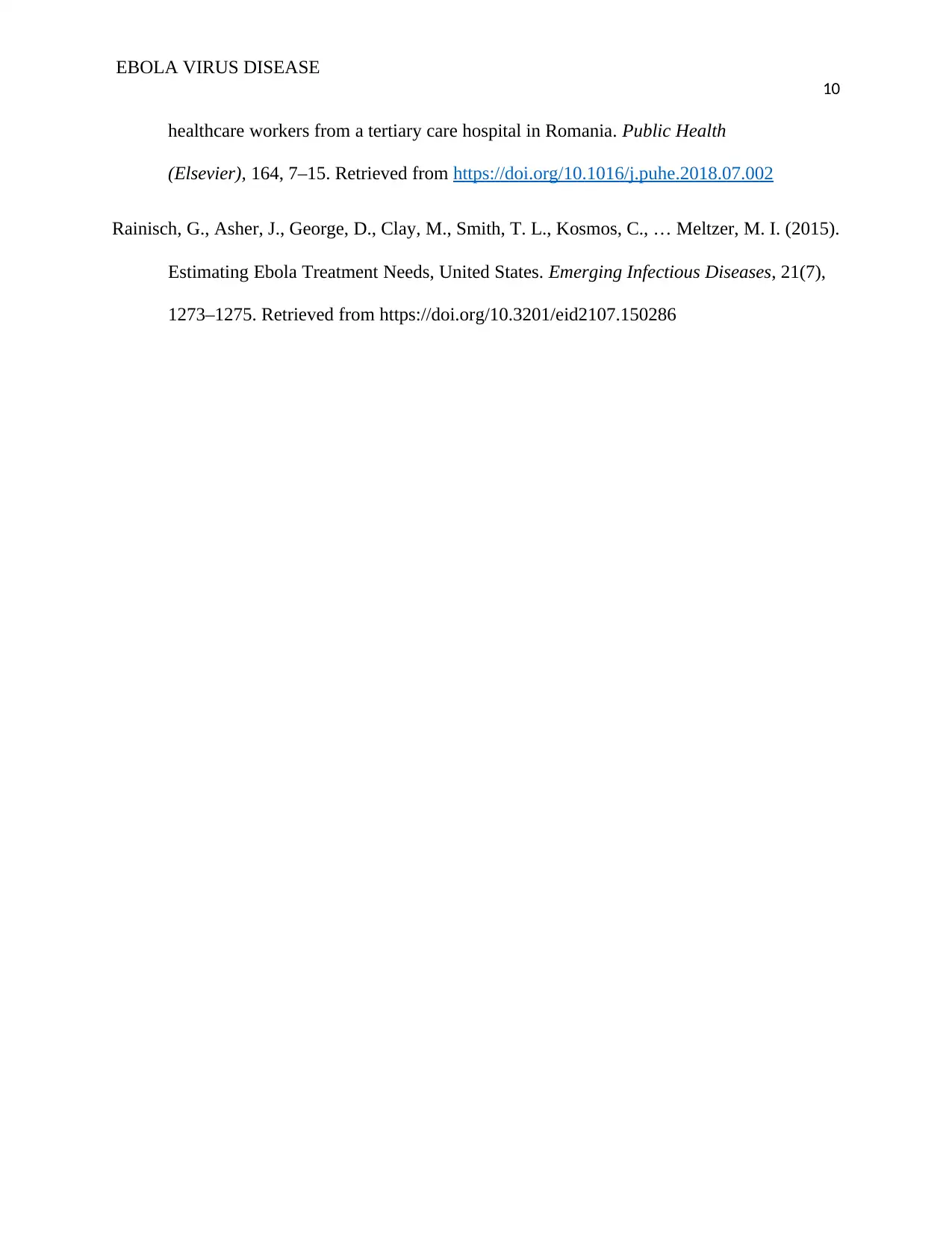
EBOLA VIRUS DISEASE
10
healthcare workers from a tertiary care hospital in Romania. Public Health
(Elsevier), 164, 7–15. Retrieved from https://doi.org/10.1016/j.puhe.2018.07.002
Rainisch, G., Asher, J., George, D., Clay, M., Smith, T. L., Kosmos, C., … Meltzer, M. I. (2015).
Estimating Ebola Treatment Needs, United States. Emerging Infectious Diseases, 21(7),
1273–1275. Retrieved from https://doi.org/10.3201/eid2107.150286
10
healthcare workers from a tertiary care hospital in Romania. Public Health
(Elsevier), 164, 7–15. Retrieved from https://doi.org/10.1016/j.puhe.2018.07.002
Rainisch, G., Asher, J., George, D., Clay, M., Smith, T. L., Kosmos, C., … Meltzer, M. I. (2015).
Estimating Ebola Treatment Needs, United States. Emerging Infectious Diseases, 21(7),
1273–1275. Retrieved from https://doi.org/10.3201/eid2107.150286
1 out of 10
Related Documents
Your All-in-One AI-Powered Toolkit for Academic Success.
+13062052269
info@desklib.com
Available 24*7 on WhatsApp / Email
![[object Object]](/_next/static/media/star-bottom.7253800d.svg)
Unlock your academic potential
© 2024 | Zucol Services PVT LTD | All rights reserved.




